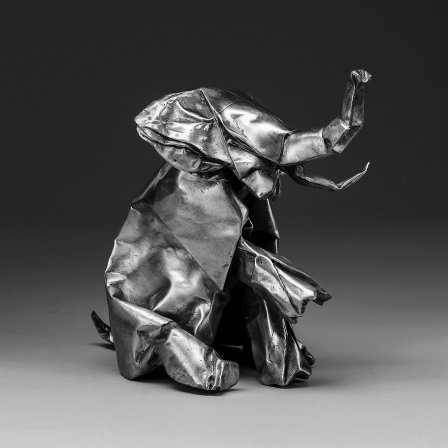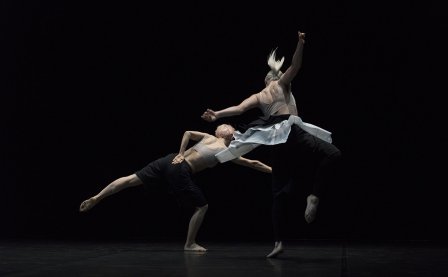There is a commonplace understanding that the true test of artificial intelligence lies in the 70-ish-year-old Turing Test, wherein a human is either able or unable to identify an agent of artificial intelligence as such. There exists another vein of criticism, however, which posits that perhaps artificial intelligence is of itself a form of perception that has only very little to do with the human perspective, and that the latter should not necessarily be litmus for the efficacy of the former. This is the perspective capable of acknowledging the Anthropocene and of conceiving of machine intelligence as something other than merely an oppressive, late-capitalist burden.
I saw Jlin perform twice at Montreal’s MUTEK festival last June: once in a field, once inside a museum gallery (respectively, a DJ set and a live set). In the field, Jlin spun footwork and juke to a crowd of eurotrash-chic teens and grayscale-clad art world adults alike, setting aside their differences to mutually lose their shit. Classic battle dance and hard-house tracks from Chicago greats — DJ Rashad, RP Boo, DJ Deeon — abutting Jlin’s own Dark Energy cuts prompted a palpable imperative movement within the Sunday-evening crowd, impacting and spreading out through groupings of bodies in observable waves. Jlin smiled through the whole performance.
Inside the Musée d’art contemporain the night previous, awareness instead squared to the atmospheric pressure of a crowd that arrived expecting to dance, bodies hanging at the midpoint between seizure and restraint, drawn close at each rhythmic turn to something uncannily distinct from the auto-propulsive stutter of footwork. Footwork music typically compels people (who don’t know how to footwork) to bop their heads around in double-time casually, like they’re vibing to a club-friendly hip-hop track. Jlin’s austere performance did not offer that channel for corporal processing: it was something unforgivingly locked-in, brash in its circumvention of the same old two-step mindset.
Gone was any trace of lighthearted juke bounce, in its place a cascade of nervous percussive ornates, at once brutally monolithic in how their crescendos landed unfailingly on the whole note yet iteratively complex on the syntactic level, never quite repeating the same phrase twice. Jlin articulated the massive mood of the rhythmic swells at the head of the room with zealous fist-pumps accentuating the whole notes. As the live performance developed, sounds more typically connoting footwork (rimshots, 808 bass and snare, that “whoosh” sound, vocals chopped beyond identification) slipped unnoticeable into the lexicon on a granular level, but they’d been redeployed into patterns allowing no refuge from its kinetic grip.
Although I assume most of the material has been altered dramatically from the inchoate strains audible in Jlin’s performance last summer, this same reorientation and reanimation of the footwork lexicon from within is what distinguishes Black Origami as a distinct stroke in the oeuvre of Jlin, Chicago (though the artist hails specifically from Gary, Indiana), and dance music lineage in general.
If footwork self-consciously deconstructed the established grammar of group movement and straightforward momentum that ghetto house and juke sought to unify, traumatically hollowing out the dance circle and exposing its center to a Promethean chain of iterations, Black Origami abstracts the discourse once again, moving from a semiotic matrix into a topographical one. The long-fermented grammar of life articulated in footwork reincarnates on Jlin’s latest record as pure, intelligent substance, imbibed and outwardly projected to cultivate a deep nod of xenolalia: the divine, unaccountable performance of a language that the speaker has never formally acquired.
The press materials for Black Origami cite a deliberate turn on the part of Jlin toward the pure core of creation, as well as an attempt to draw influence from collaboration with Indian dancer Avril Stormy Unger. There is an antagonism seeded within this construction of artistic intention that characterizes a prominent tension on the record: there are more tongues, more symbols, more strokes, more metrics, more compositional strategies (via Jlin’s collaborators, among them the infamous minimalist William Basinski, cyborg vocalist Holly Herndon, and neo-futurist producer Fawkes) here than ever before (even for a record in a sample-based lineage), yet the micro-breakdowns inherent in its proud heteroglossia sketch at the shadow-outline of a deep, unitary substance — that same dark energy, distilled and machine-learning its own genus of ornates.
The title track kicks off this unfunky, machinic skittering, orchestrated with a polyphony of oblique, inward-folding voices that glide over and under one another. In conjunction with biomorphic vocal sounds, “Black Origami” invokes a sense of deep reverence, underpinned with cyborgian anxiety and the suggestion of internal collapse. Timbrel strikes of tonal Indian drums function in much the same way an 808 tom conveys a pitch and frequency that, upon repetition, casts a chordal wash over even tracks bereft of conventional melody or dance music structures. Bird’s-eye surveillance topography of rhythmic structure is indeed the departure that enables compositions like these to emerge, one that tends inward towards the singularity of Jlin’s vision as much as it pulls from the scope of her influences.
“Enigma” and “Kyanite” follow in the same vein, accordingly accelerating the physical denial of simple resolution and calibrating to the neo-baroque sense of rupture and awe at the indistinct precipice of intuition and algorithmic sequence — the compositional palette parallels this, juxtaposing the spirit-exulting harshness of devotional reed instruments, breathless vocals (as on William Basinski-featuring [!!] “Holy Child”) with an evasive low end of mutating bass and tom patterns. Elsewhere, as on “Hatsepshut” and gripping album closer “Challenge (To Be Continued),” the same rhythmic pattern absorbs a militaristic drum-and-fife band rattle, landing somewhere between the playful ritualism of college drumline and an autopoetic war machine. This ambivalence, too, seems central to Jlin’s work, brutality never truly resolving against almost humorous moments of absurdity.
Themes of energy mining, chemical process, and energetic substance come to the fore on Black Origami both nominally (with track titles like “Kyanite,” “Calcination,” “Carbon 7 (161),” and “Never Created, Never Destroyed”) and in the manner that Jlin’s indelible rhythmic imprint mutates a lexicon of irresolvable heterogenous symbols and sounds. Take “1%,” whose sample bank deploys gestural, functional sound designs from across different genres of media and communication: the ascending whine sound that introduces the lead up to a chorus in drill music abuts the dead line sample from American landline phones (“We’re sorry, your call has not gone through…”) and the death warning of the Red Queen from Resident Evil.
This type of pan-cultural sampling is nothing new in the footwork lineage, but within the context of Black Origami’s intensifying last gasps, the gesture forcefully conveys a deep disjuncture, a vast traumatic gulch belying the convergence of multifarious semiotics that converges in machine intelligence, which anxiously surveils the dwindling energetic substances anchoring planetary biology and the ever-widening imprint of its own activities. The onus of Black Origami is neither to tame nor slay this chimera, but to trace its motions and pay exulted tribute. What emerges is a baroque topography of movement and energy, culled from the explosion of an ultra-specific cultural context outwards, and then back into the dusk.
More about: Jlin




